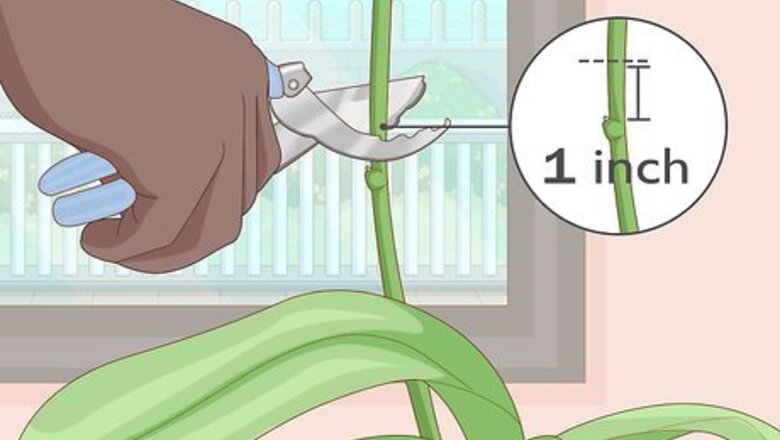
views
X
Expert Source
Rachel GuffeyPlant Specialist
Expert Interview. 5 August 2021.
Getting your orchid to rebloom requires proper sunlight, water, fertilization, temperature control, and some patience, as it can take 6 to 9 months for it to flower again. We spoke with several plant specialists to learn the best way to get your orchid to rebloom, including how to care for your plant while it's dormant. Read on below!
Maintaining Your Dormant Orchid
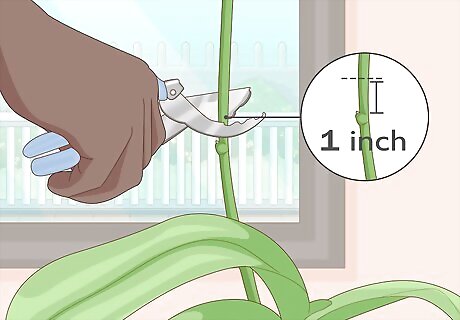
Cut the flower spike 1 inch (2.5 cm) above the healthiest node. After all of the flowers fall off your orchid, find a node on the orchid’s stem. The node looks like a small green bulge and the healthiest node is typically the one closest to the last blooming flower. Then, grab a pair of clean, sharp gardening shears or scissors and snip off the stalk 1 inch (2.5 cm) above the node. Sterilize your gardening shears or scissors by wiping them with rubbing alcohol. This kills any potentially harmful bacteria. If all of the nodes look brown and unhealthy, cut the stalk to the base of the plant just above a node. Most orchid varieties enter a period of dormancy after they bloom and drop their flowers. They have to rest because they use up so much energy blooming. New flower spikes usually grow from the orchid’s nodes. Cutting away dead or unhealthy parts of the stalk helps prepare the plant to rebloom by concentrating its nutrients in the healthiest node.
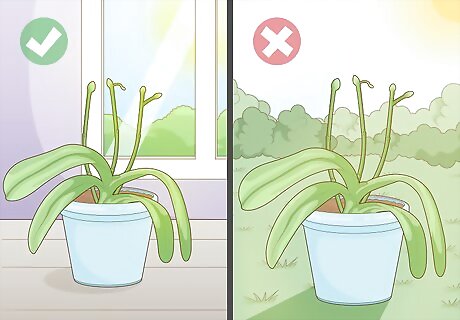
Put your orchid in a warm spot that receives indirect light. Orchids grow best in warm temperatures, so choose a spot that stays between 60 to 85°F (15-29°C). Plant specialist Harmony Corelitz says that “bright filtered sun is always best” for orchids instead of “direct sun.” Monique Capanelli, another plant specialist, agrees and recommends placing orchids on an “Eastern facing windowsill.” Monitor your orchid's leaves to ensure it’s getting enough sunlight. Dark green leaves typically indicate an orchid isn't getting enough light while lighter, grass-colored leaves indicate that your orchid is getting enough light.
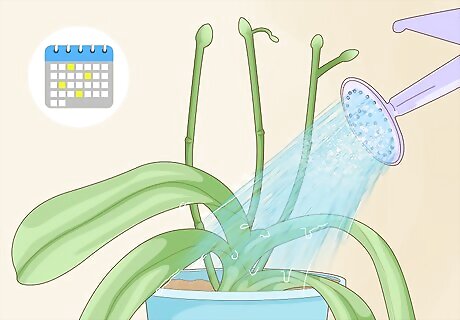
Water your orchid once a week or when the soil feels dry. Expert gardener Matt Bowman says “overwatering is a very common problem with orchids.” To ensure your orchid gets enough water, he recommends giving your orchid about “a shot glass of water per week,” or 1.5 oz (44 mL). Plant specialist Harmony Corelitz says to make sure the orchid’s potting medium is “actually drying out all the way in between watering,” too. When you water your orchid, plant specialist Rachel Guffey recommends “taking it to the sink and flushing the pot with water, allowing all of the roots a few seconds to rinse down. Avoid getting water in the crooks of the green leaves.” Ensure your orchid gets a lot of humidity, too. Fill a tray 1 inch (2.5 cm) deep with pebbles and ½ inch (1.3 cm) deep with water. Then, set your orchid on the tray.
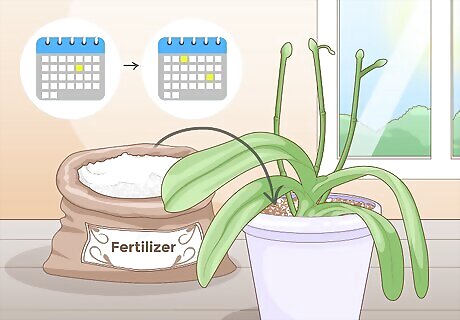
Fertilize your orchid once a month. Replenishing the nutrients in your orchid's soil helps it gather the strength it needs to rebloom. Simply dilute a balanced, water-soluble houseplant fertilizer to ¼ or ½ strength. Then, water your orchid with it about once per month. For instance, use a 20-20-20 fertilizer. This means it contains a mixture of 20% phosphorus, 20% nitrogen, and 20% potassium.
Triggering an Orchid to Rebloom

Move the orchid to a cool spot at night when a new leaf grows. Over the next few months, watch for new leaves growing on your orchid. When you spot new growth, set your orchid in a spot where the temperature ranges between 55 to 65°F (13-18°C) at night. The cooler temperatures tell your orchid that it's time to rebloom. You might move your orchid closer to the window in the evenings or open the window. Or, set it outside at night. If temperatures drop below 50°F (10°C), move the orchid back indoors or to its warm spot. Note: Some orchid species have different temperature needs. Check out your orchid’s temperature needs using this list from the BBC’s Gardeners’ World Magazine or search for your orchid variety online. Note: It can take several months for your orchid to grow a new leaf. Many orchid varieties stay in their dormant period for 6 to 9 months. Experiencing cool evenings and warm days mimics the orchid's natural rainforest environment where the temperature drops at night.
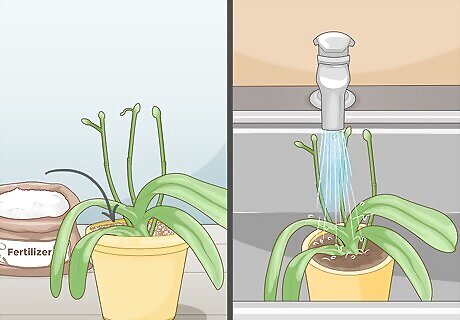
Fertilize the orchid every 1-2 weeks and water it regularly. When your orchid starts growing leaves, it needs more nutrients than it did while it was dormant. Every 1 to 2 weeks, fertilize it with a balanced, water-soluble fertilizer diluted to ¼ strength. Then, keep watering it about once per week, or whenever the soil feels dry. To reduce the risk of overwatering your orchid, only water it when the soil is completely dried out. Simply stick your finger in the soil to see how it feels.
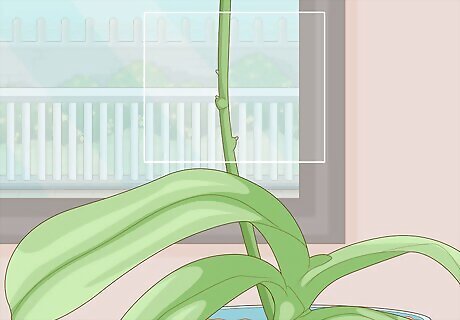
Look for a new flower spike growing after about 1 month. Look for signs that your orchid is getting ready to rebloom after about 1 month of it being in its cooler location. When your orchid is getting ready to rebloom, you’ll see a root-like stem growing out of the stalk you previously cut. This is your orchid’s new flower spike. Note: Try to be patient! Orchids can take over a year to rebloom. If your orchid isn’t growing a new flower spike after 1 to 2 months, feed it with a bloom booster fertilizer. This can help trigger your orchid to rebloom. Your orchid might grow an entirely new flower spike out of the base of the plant instead of at the node you cut previously. New flower spikes are fully formed when they develop a rounded end and take the shape of a mitten.

Move your orchid to its warm spot and water and fertilize it regularly. When a new flower spike starts to grow on your orchid, set it back in its original spot where it gets indirect light and stays between 60 to 85°F (15-29°C). Just keep watering it when the soil feels dry and giving it fertilizer diluted to ¼ strength every 1 to 2 weeks.
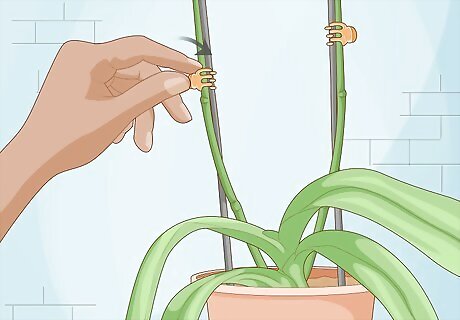
Clip the stalk to a stake when it's about 5 inches (12 cm) long. If your orchid doesn’t already have a stake, insert one into the soil; this helps keep your orchid straight and supports the weight of new flowers. When the new flower spike grows 5 inches (12 cm) long, use a plastic clip or plant tie to secure the stalk to the stake. Clipping the stalk to the stake when it’s still short can potentially inhibit its growth. When a stalk starts developing flowers, it's done growing.
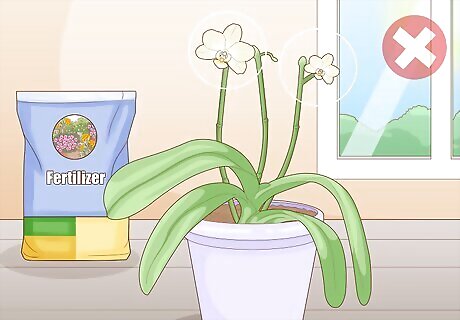
Stop fertilizing the orchid when the flower blooms. Watch and wait for the flower spike to completely grow, develop buds, and bloom flowers. When the flowers open up, discontinue your weekly or biweekly fertilizer routine.
How long does it take for an orchid to rebloom?
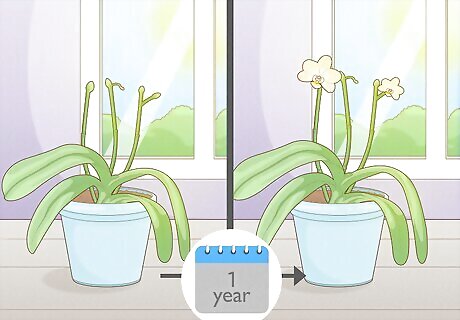
It takes most orchid varieties 1 year to rebloom. Blooming flowers uses up a lot of an orchid’s energy, so it enters a period of dormancy to restore its lost energy. This rest period can last from 6 months to up to 1 year, depending on the variety of your orchid. Continuing to care for your orchid during its dormancy and following the steps to trigger a rebloom helps ensure that it will flower again.
How to Tell If Your Orchid Will Rebloom
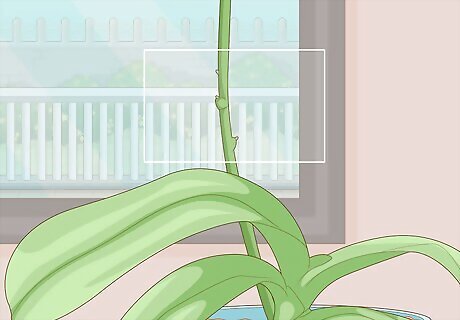
Look for a new flower spike growing to tell if your orchid will rebloom. A new flower spike growing from the node you cut or out of the base of the plant is a telltale sign that your orchid is gearing up to rebloom. As the new stem grows, you’ll likely see small buds forming on the spike. Flowers will only bloom out of spikes that are green. Yellow or brown spikes are a sign that the stems are dying or dead.
Keeping Your Orchid Healthy
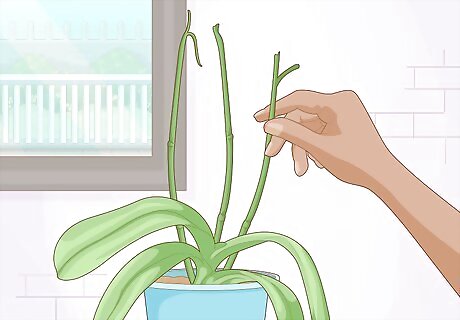
Make sure the spikes and leaves are still green. Even when an orchid loses all of its flowers and enters dormancy, the spike and leaves should still be green and well-hydrated. This indicates that the plant is still alive and reblooming is possible. Depending on your type of orchid, the leaves might fall off during dormancy too. In this case, inspect the stalk and make sure it's still green and healthy. Signs that an orchid is dead or dying include a yellowing or browning stalk and dark spots and signs of withering on the leaves.
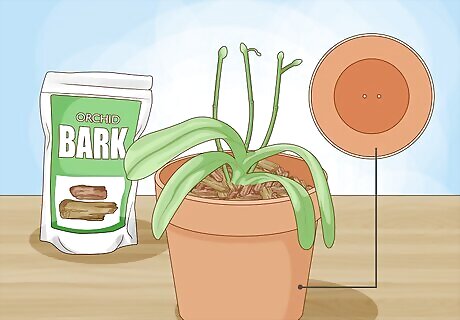
Repot the orchid in a pot with drainage holes using orchid bark. Plant specialist Harmony Corelitz says orchids “need to be repotted yearly” to stay healthy. She recommends “keeping [the orchid] in a fairly small pot… that's 1 inches or 2 inches [2.5-5 cm] wider in diameter” than the original pot. Just choose a pot with drainage holes and fill it with just bark or a mix of bark and sphagnum moss. To repot the orchid, carefully take it out of its original container. Fill the new pot about ⅓ full with the potting mix. Then, insert the orchid and fill the rest of the pot with the mix. Plant specialist Harmony Corelitz explains that orchids “are epiphytic,” which means their “roots need a lot of aeration and drainage.” You don’t plant orchids in regular potting soil because it can “cause [their] aerial roots to rot” and damage the plant.
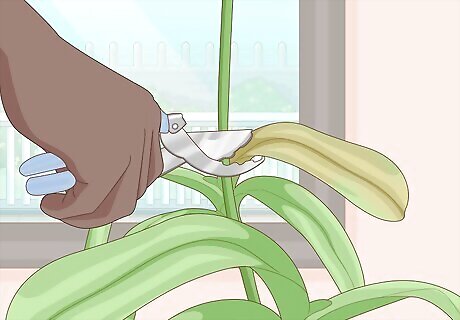
Prune the orchid by cutting off yellowing stems and leaves. Regularly check your orchid for yellowing or browning leaves and stems, which means these parts of the plant are dying or dead. Just use a pair of sharp, clean cutting shears or scissors and snip off the dying leaf or stem.




















Comments
0 comment